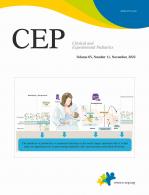Article Contents
| Clin Exp Pediatr > Volume 65(11); 2022 |
|
Over the past two and a half years, the coronavirus disease 2019 (COVID-19) pandemic has infected many children and adolescents worldwide. In the Republic of Korea, the incidence of COVID-19 in children and adolescents has increased substantially during the Omicron subvariant epidemic. As of August 3, 2022, the cumulative number of COVID-19 patients aged 0–19 years reached 4,975,813, representing 58.6% of the population in this age group. In addition, a high proportion (15%–20%) of all recent new daily cases are younger than 18 years of age [1]. In addition, as of August 3, 2022, a total of 41 deaths due to COVID-19 in the 0–19 years age group have been recorded. Among them, 85% occurred in the past five months [2].
With the emergence of Omicron subvariants, which have a high transmission rate, the incidence of COVID-19 is increasing significantly in children and adolescents. Therefore, there is an urgent need for a safe, efficient, and sustainable response of the healthcare system to the COVID-19 outbreak in children and adolescents in the Republic of Korea. The current COVID-19 wave caused by the BA.4/BA.5 Omicron subvariants is expected to peak in August 2022. Therefore, the number of pediatric patients with symptomatic infections and critical conditions is also expected to increase, and the demand for medical care will increase the burden on the healthcare system for the pediatric population. In this context, the Korean Pediatric Society and Korean Society of Pediatric Infectious Diseases united to formulate the following statement, emphasizing the importance of reassessing the healthcare system to guarantee the health and safety of children and adolescents despite the surge of the Omicron BA.4/BA.5 subvariants.
Although most children and adolescents have a mild disease course, severe infections or complications may occur among those with underlying diseases. In addition, as the number of confirmed cases increases, various manifestations of COVID-19 infection, including croup, bronchiolitis, and febrile convulsions, are expected to occur among previously healthy children and adolescents. Severe cases such as myocarditis and encephalitis are also expected to occur. Therefore, the health authority must reassess the medical system in response to rapidly increasing pediatric COVID-19 cases. To accomplish this, we must establish a collaborative system among pediatricians, pediatric infectious disease specialists, and health authorities that develops effective and proactive policies based on the understanding of the rapidly changing daily healthcare situations of the pediatric population with COVID-19.
The medical needs of pediatric patients differ from those of adults. Children often do not express their symptoms clearly, most require a guardian when hospitalized, and many have high nursing needs. The current medical situation is challenging, especially in tertiary hospitals, operating rooms, intensive care units, and emergency medical services, due to the shortage of on-call pediatricians. Therefore, policy support from the healthcare authorities should be provided for preparing professional medical personnel to treat serious pediatric COVID-19 patients. A systematic approach and prompt countermeasures should be applied to establish an appropriate healthcare system for pediatric COVID-19 patients.
Pediatric COVID-19 patients often require medical care during the isolation periods. Despite the efforts of health authorities, the system requires improvement.
One-stop COVID-19 care should also be available for pediatric patients. Accordingly, health policies such as health insurance cost support and compensation should be improved to encourage primary care pediatricians to actively provide COVID-19 patient care. Moreover, local infrastructure and medical staff should be secured when blood tests, chest radiography, or fluid therapy are required for pediatric patients. Above all, national coordination and support systems are required to enable the referral of pediatric patients with severe or critical status to emergency rooms or secondary or tertiary care centers to ensure appropriate and timely care.
The importance of preventing the spread of COVID-19 cannot be overemphasized. However, the delivery of essential medical care such as delivery, emergency surgery, and other illnesses should not be delayed, and long-distance patient transportation resulting from isolation issues should be avoided.
In addition, national support and efforts are required to ensure that general and essential medical care related to the health of children and adolescents can be maintained appropriately despite the surge in COVID-19 patients.
In response to the Omicron subvariant epidemic, we request that the medical system be reassessed to secure the healthcare system for the pediatric population.
References
1. Korea Disease Control and Prevention Agency. The updates of COVID19 in Republic of Korea, as of 3 August 2022 [Internet]. Cheongju (Korea): Korea Disease Control and Prevention Agency; 2022 [cited 2022 Aug 3]. Available from: https://www.kdca.go.kr/board/board.es?mid=a20501010000&bid=0015&list_no=720322&cg_code=&act=view&nPage=4.
2. Korea Disease Control and Prevention Agency. Coronavirus (COVID-19), Republic of Korea, occurrence status [Internet]. Cheongju (Korea): Korea Disease Control and Prevention Agency; 2022 [cited 2022 Aug 3]. Available from: http://ncov.mohw.go.kr/.





 PDF Links
PDF Links PubReader
PubReader ePub Link
ePub Link PubMed
PubMed Download Citation
Download Citation


